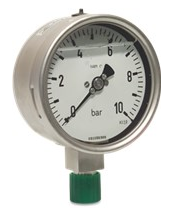- Last updated Jan 07, 2022
- Livestock, Measurement Filtration and Regulation
Venting of Liquid Filled Pressure Gauges
Need for Venting
Pressure gauges used for low pressure application (below 20 bar) requires proper venting to ensure its accuracy. Without proper venting, the liquid gauge record not so accurate results and caution must be taken to be perform the ventilation only after installation so as to avoid any leakages during transit. When there are temperature fluctuations, the liquid expands or contracts and this waiver a pressure surge, which in turn yields a force that impede with the pressure gauge reading and results in zero point error. This surge can offset the accuracy by approximately 0.07 bar for change per 20˚C of temperature, but it is only noticeable when measuring lower pressures, less than 1 bar.
How to Perform Venting
The venting ports of pressure gauges are equipped with either a solid rubber type or with split piece lever type filling plugs.
1. Solid Rubber Type:
Firstly slash the tip of the plug which will open a small hole through so the gauge can be vented properly. The vented rubber type plugs should not be installed either in a slanting or horizontal position.

Fig. 1: Pressure gauge with a Rubber Vent Port at its top
2. Lever Type:
The levers in this pressure gauges are usually sealed and must be unlocked during installation to prevent any possible pressure build up in the case. The lever is in the form of a split nut, that can be turned half and is used to vent the gauge by advancing to its open position, which in turn allows the pressure gauge to bleed the excess pressure built up inside the gauge. If the gauge is installed in an vertical orientation, the lever can be kept in the open position.
Validating Proper Ventilation
A sign to look for to confirm that your liquid filled gauge with the solid rubber type fill plug is vented correctly after installation, is to make sure glycerin comes out of the gauge after you snip the fill plug using a sharp edged instrument. If glycerin doesn't leak, take a smaller sharp edged instrument like a paper clip and insert into the hole of the fill plug, check for the traces of glycerin on the end of the tool when it is withdrawn. If traces of glycerin is present, venting was performed accurately else the depth of the cut needs to be more deeper. In case of a liquid filled gauge with the lever type fill plug, advance the yellow valve to the open position.